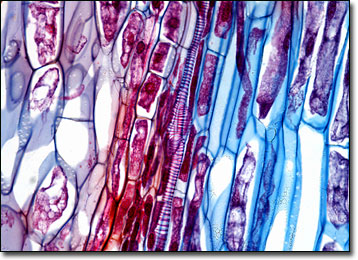Brightfield Microscopy Digital Image Gallery
Horsetail Strobilus
Members of the genus Equisetum, horsetails are a type of hollow-stemmed plant that exhibits an extensive creeping root system. Sometimes alternatively known as horse pipes, mareís tail, or snake grass, horsetails thrive best in damp environments, such as swamps, bogs, and stream banks.

Horsetail plants have a very ancient lineage that extends back some 200 million years. Similar to other primitive vascular plants, they exhibit an asexual reproductive structure, the sphenophyte strobilus, more commonly known as a cone. Unlike the better-known pinecone, however, the strobili of the horsetail plant may only contain one type of spore since they are homosporous. Horsetail cones, each of which encases many sporophylls within a single sporangium or case, form along the uppermost region of the plantís branches. When the sporophylls are dispersed by the wind, they germinate into small, free-living gametophytes that may produce either male or female reproductive organs. If these gametophytes are exposed to enough moisture, the sperm cells are released from the male organs and swim through the water to fertilize female eggs, beginning the next phase of the plantís life cycle.
Two different types of hollow-jointed stems are produced by the horsetail, both of which are maintained by food reserves stored in small tubers. These tubers are produced along the plantís vast root system, which is actually comprised of rhizomes, subterranean horizontal plant stems that may penetrate deep into the soil. Due to the tenacious rhizomes, horsetails often form immense weed-like colonies in areas plagued by poor drainage, sometimes becoming a problematic species in orchards and fields. However, one variety of the plant, commonly known as the scouring rush, is commercially valuable. This type of horsetail stores a significant level of silica granules in its cells and is often used to produce abrasive powders for scrubbing pots and pans.
BACK TO THE BRIGHTFIELD MICROSCOPY IMAGE GALLERY
